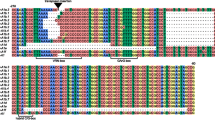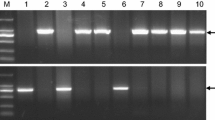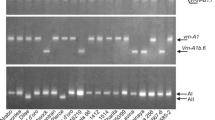Abstract
The heading time in wheat and some other cereals is mainly determined by the genetic system of VRN (vernalization response) and PPD (photoperiod response) genes. Using diagnostic DNA markers, we analyzed VRN-A1, VRN-B1, VRN-D1, and PPD-D1 allelic diversity in a set of landraces representing seven hexaploid spring wheat species from several regions of Eurasia. The determination of the spring growth habit was found to be variable: in 55.3% accessions, it was controlled monogenically by a VRN gene; in 30.3% accessions, by a combination of two VRN genes; and in 2.6% accessions, trigenically. The dominant Ppd-D1a allele was almost completely absent (only 2.6%) in the landraces, which suggests it being secondary to the recessive ppd-D1b allele as well as increase in its frequency during the recent “green revolution.” In species T. aestivum, Т. compactum, T. petropavlovskyi, and T. tibetanum, the Vrn-D1a frequency was shown to increase eastward with maximum concentration in the regions of Afghanistan, India, and China. In species with a compact ear (T. antiquorum, T. sphaerococcum, and Asian forms of Т. compactum), the spring growth habit is controlled by a single Vrn-B1a allele, which indicates their possible initial distribution in the same gene pool. The European and Asian T. spelta subspecies, despite the very fragmented distribution range, have the same Vrn-A1b and Vrn-B1c alleles, which genetically unites these subspecies. A common set of alleles of the VRN genes in landraces and modern cultivars have provided the adaptability of wheat to diverse environmental conditions during the long period of its cultivation. The newly detected DNA fragments in the first intron of VRN-D1 and PPD-D1 loci may mark new alleles and be of interest for further examination and use in breeding programs.


Similar content being viewed by others
REFERENCES
Stelmakh, A.F., Genetic effects of Vrn genes on heading date and agronomic traits in bread wheat, Euphytica, 1993, vol. 65, pp. 53—60. https://doi.org/10.1007/BF00022199
Worland, A.J., Börner, A., Korzun, V., et al., The influence of photoperiod genes on the adaptability of European winter wheats, Euphytica, 1998, vol. 100, pp. 385—394. https://doi.org/10.1023/A:1018327700985
Li, C.X., Lin, H.Q., Chen, A., et al., Wheat VRN1, FUL2 and FUL3 play critical and redundant roles in spikelet development and spike determinacy, Development, 2019, vol. 146, pp. 1—11. https://doi.org/10.1101/510388
Debernardi, J.M., Greenwood, J.R., Finnegan, E.J., et al., APETALA 2-like genes AP2L2 and Q specify lemma identity and axillary floral meristem development in wheat, Plant J., 2020, vol. 101, pp. 171—187. https://doi.org/10.1111/tpj.14528
Distelfeld, A., Li, C., and Dubcovsky, J., Regulation of flowering in temperate cereals, Curr. Opin. Plant Biol., 2009, vol. 12, pp. 178—184. https://doi.org/10.1016/j.pbi.2008.12.010
Yan, L., Loukoianov, A., Tranquilli, G., et al., Positional cloning of the wheat vernalization gene VRN1, Proc. Natl. Acad. Sci. U.S.A., 2003, vol. 100, no. 10, pp. 6263—6268. https://doi.org/10.1073/pnas.0937399100
Yan, L., Helguera, M., Kato, K., et al., Allelic variation at the VRN-1 promoter region in polyploidy wheat, Theor. Appl. Genet., 2004, vol. 109, no. 8, pp. 1677—1686. https://doi.org/10.1007/s00122-004-1796-4
Kippes, N., Zhu, J., Chen, A., et al., Fine mapping and epistatic interactions of the vernalization gene VRN-D4 in hexaploid wheat, Mol. Genet. Genomics, 2014, vol. 289, pp. 47—62. https://doi.org/10.1007/s00438-013-0788-y
Yan, L., Fu, D., Li, C., et al., The wheat and barley vernalization gene VRN3 is an orthologue of FT, Proc. Natl. Acad. Sci. U.S.A., 2006, vol. 103, pp. 19581—19586. https://doi.org/10.1073/pnas.0607142103
Fu, D., Szücs, P., Yan, L., et al., Large deletion within the first in Vrn-1 are associated with spring growth habit in barley and wheat, Mol. Gen. Genet., 2005, vol. 273, no. 1, pp. 54—65. https://doi.org/10.1007/s00438-004-1095-4
Kato, H., Taketa, S., Ban, T., et al., The influence of a spring habit gene Vrn–D1, on heading time in wheat, Plant Breed., 2001, vol. 120, pp. 115—120. https://doi.org/10.1046/j.1439-0523.2001.00586.x
Trevaskis, B., The central role of the VRN1 gene in the vernalization response of cereals, Funct. Plant Biol., 2010, vol. 37, pp. 479—487. https://doi.org/10.1071/FP10056
Shcherban, A.B., Efremova, T.T., and Salina, E.A., Identification of a new Vrn-B1 allele using two near-isogenic wheat lines with difference in heading time, Mol. Breed., 2012, vol. 29, no. 3, pp. 675—685. https://doi.org/10.1007/s11032-011-9581-y
Dorofeev, V.F., Pshenitsy mira (Wheats of the World), Leningrad: Kolos, 1976.
Cockram, J., Jones, H., Leigh, F.J., et al., Control of flowering time in temperate cereals: genes, domestication, and sustainable productivity, J. Exp. Bot., 2007, vol. 58, pp. 1231—1244. https://doi.org/10.1093/jxb/erm042 PMID:17420173
Blake, N.K., Lanning, S.P., Martin, J.M., et al., Effect of variation for major growth habit genes on maturity and yield in five spring wheat populations, Crop Sci., 2009, vol. 49, pp. 1211—1220. https://doi.org/10.2135/cropsci2008.08.0505
Díaz, A., Zikhali, M., Turner, A.S., et al., Copy number variation affecting the Photoperiod–B1 and Vernalization–A1 genes is associated with altered flowering time in wheat (Triticum aestivum), PLoS One, 2012, vol. 7, no. 3. e33234. https://doi.org/10.1371/journal.pone.0033234
Andeden, E.E., Yediay, F.E., Baloch, F.S., et al., Distribution of vernalization and photoperiod genes (Vrn-A1, Vrn-B1, Vrn-D1, Vrn-B3, Ppd-D1) in Turkish bread wheat cultivars and landraces, Cereal Res. Commun., 2011, vol. 39, no. 3, pp. 352—364. https://doi.org/10.1556/CRC.39.2011.3.5
Likhenko, I.E., Stasyuk, A.I., Shcherban’, A.B., et al., Study of allelic composition of Vrn-1 and Ppd-1 genes in early–ripening and middle–early varieties of spring soft wheat in Siberia, Russ. J. Genet., Appl. Res., 2015, vol. 5, pp. 198—207. https://doi.org/10.1134/S2079059715030107
Kiss, T., Balla, K., Veisz, O., et al., Allele frequencies in the VRN-A1, VRN-B1 and VRN-D1 vernalization response and PPD-B1 and PPD-D1 photoperiod sensitivity genes, and their effects on heading in a diverse set of wheat cultivars (Triticum aestivum L.), Mol. Breed., 2014, vol. 34, pp. 297—310. https://doi.org/10.1007/s11032-014-0034-2
Yankovskaya, A.A., Fisenko, A.V, and Dragovich., A.Yu., Genetic diversity of spring bread wheat varieties from the European part of Russia at the VRN and PPD genes affecting heading time, Genetica (Moscow), 2018, vol. 54, no. 13, pp. S32—S36. https://doi.org/10.1134/S0016675818130209
Grogan, S.M., Brown-Guedira, G., Haley, S.D., et al., Allelic variation in developmental genes and effects on winter wheat heading date in the U.S. Great Plains, PLoS One, 2016, vol. 11, no. 4. e0152852. https://doi.org/10.1371/journal.pone.0152852
Dobrotvorskaya, T.V., Martynov, S.P., and Pukhalskyi, V.A., Trends in genetic diversity change of spring bread wheat cultivars released in Russia in 1929—2003, Russ. J. Genet., 2004, vol. 40, no. 11, pp. 1245—1257. https://doi.org/10.1023/B:RUGE.0000048667.39464.54
Novoselskaya-Dragovich, A.Y., Fisenko, A.V., Imasheva, A.G., and Pukhalskiy, V.A., Comparative analysis of the genetic diversity dynamics at gliadin loci in the winter common wheat Triticum aestivum L. cultivars developed in Serbia and Italy over 40 years of scientific breeding, Russ. J. Genet., 2007, vol. 43, no. 11, pp. 1236—1242. https://doi.org/10.1134/S1022795407110051
Goncharov, N.P., Sravnitel’naya genetika pshenits i ikh sorodichei (Comparative Genetics of Wheat and Their Relatives), Novosibirsk: Geo, 2012, 2nd ed.
Potokina, E.K., Koshkin, V.A., Alekseeva, E.A., et al., The combination of the Ppd and Vrn gene alleles determines the heading date in common wheat varieties, Russ. J. Genet., Appl. Res., 2012, vol. 2, no. 4, pp. 311—318. https://doi.org/10.1134/S2079059712040089
McIntosh, R.A., Yamazaki, Y., Dubcovsky, J., et al., Catalogue of Gene Symbols for Wheat, in The 11th International Wheat Genetics Symposium, Brisbane, Australia, 2008.
Torres, A.M., Weeden, N.F., and Martin, A., Linkage among isozyme: RFLP and RAPD markers in Vicia faba, Theor. Appl. Genet., 1993, vol. 85, pp. 937—945. https://doi.org/10.1007/BF00215032
Beales, J., Turner, A., Griffiths, S., et al., A pseudo-response regulator is misexpressed in the photoperiod insensitive Ppd-D1a mutant of wheat (T. aestivum L.), Theor. Appl. Genet., 2007, vol. 115, no. 5, pp. 721—733. https://doi.org/10.1007/s00122-007-0603-4
Yakubtsiner, M.M., On the history of wheat culture in the USSR, in Materialy po istorii zemledeliya v SSSR (Materials on the History of Agriculture in the USSR), Leningrad: Nauka, 1956, pp. 16—169.
Stel’makh, A.F. and Avsenin, V.I., Domestic varieties of spring bread wheat—carriers of Vrn gene, Nauchno-Tekh. Byull. Vses. Sel.-Genet. Inst., 1983, issue 4(50), pp. 32—36.
Chen, A. and Dubcovsky, J., Wheat tilling mutants show that the vernalization gene VRN1 down-regulates the flowering repressor VRN2 in leaves but is not essential for flowering, PLoS Genet., 2012, vol. 8, no. 12. e1003134. https://doi.org/10.1371/journal.pgen.1003134
Kippes, N., Chen, A., Zhang, X., et al., Development and characterization of a spring hexaploid wheat line with no functional VRN2 genes, Theor. Appl. Genet., 2016, vol. 129, no. 7, pp. 1417—1428. https://doi.org/10.1007/s00122-018-3141-3
Allard, V., Veisz, O., Kõszegi, B., et al., The quantitative response of wheat vernalization to environmental variables indicates that vernalization is not a response to cold temperature, J. Exp. Bot., 2012, vol. 63, no. 2, pp. 847—857. https://doi.org/10.1093/jxb/err316
Muterko, A., Kalendar, R., and Salina, E., Novel alleles of the VRN1 genes in wheat are associated with modulation of DNA curvature and flexibility in the promoter region, BMC Plant Biol., 2016, vol. 16, pp. 65—81. https://doi.org/10.1186/s12870-015-0691-2
Golovnina, K.A., Kondratenko, E.Y., Blinov, A.G., and Goncharov, N.P., Molecular characterization of vernalization loci VRN1 in wild and cultivated wheats, BMC Plant Biol., 2010, vol. 10, p. 168. https://doi.org/10.1186/1471-2229-10-168
Diallo, A.O., Ali-Benali, M.A., Badawi, M., et al., Expression of vernalization responsive genes in wheat is associated with histone H3 trimethylation, Mol. Genet. Genomics, 2012, vol. 287, no. 7, pp. 575—590. https://doi.org/10.1007/s00438-012-0701-0
Gryaznevich, P.A., Historical and archeological monuments of ancient and medieval Yemen: field studies 1970—1971, in Yuzhnaya Araviya: pamyatniki drevnei istorii i kul’tury (South Arabia: Monuments of Ancient History and Culture), St. Petersburg, 1994, issue 2, part 1.
Badaeva, E.D., Dedkova, O.S., Pukhalskiy, V.A., et al., Chromosomal passports provide new insights into diffusion of emmer wheat, PLoS One, 2015, vol. 10, no. 5, pp. e0128556. https://doi.org/10.1371/journal.pone.0128556
Shcherban, A.B., Boerner, A., and Salina, E.A., Effect of VRN-1 and PPD-D1 genes on heading time in European bread wheat cultivars, Plant Breed., 2015, vol. 134, pp. 49—55. https://doi.org/10.1111/pbr.12223
Udachin, R.A., On the possible current existence of Triticum antiquorum Heer, Naucho-Tekhn. Byull. Vses. Nauchno-Issled. Istor. Rastenievod., 1982, no. 119, pp. 72—73.
Feldman, M., The World Wheat Book: A History of Wheat Breeding, Intercept: London, 2001.
Novoselskaya-Dragovich, A.Yu., Fisenko, A.V., Konovalov, F.A., et al., Analysis of genetic diversity and evolutionary relationships among hexaploid wheats Triticum L. using LTR-retrotransposon-based molecular markers, Genet. Resour. Crop Evol., 2018, vol. 65, pp. 187—198. https://doi.org/10.1007/s10722-017-0520-6
Dedkova, O.S., Badaeva, E.D., Mitrofanova, O.P., et al., Analysis of intraspecific divergence of hexaploid wheat Triticum spelta L. by C-banding of chromosomes, Russ. J. Genet., 2004, vol. 40, no. 10, pp. 1111—1126. https://doi.org/10.1023/B:RUGE.0000044755.18085.7e
Yang, F.P., Zhang, X.K., Xia, X.C., et al., Distribution of photoperiod insensitive Ppd-D1a allele in Chinese wheat cultivars, Euphytica, 2009, vol. 165, pp. 445—452. https://doi.org/10.1007/s10681-008-9745-y
Author information
Authors and Affiliations
Corresponding author
Ethics declarations
The authors declare that they have no conflict of interest.
The studies were performed without the use of animals and without the involvement of human subjects.
Additional information
Translated by A. Lisenkova
Rights and permissions
About this article
Cite this article
Dragovich, A.Y., Fisenko, A.V. & Yankovskaya, A.A. Vernalization (VRN) and Photoperiod (PPD) Genes in Spring Hexaploid Wheat Landraces. Russ J Genet 57, 329–340 (2021). https://doi.org/10.1134/S1022795421030066
Received:
Revised:
Accepted:
Published:
Issue Date:
DOI: https://doi.org/10.1134/S1022795421030066




